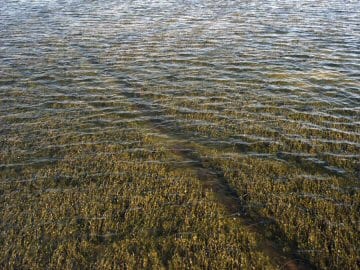 Beginning Sept. 1, a new law passed by the 83rd Texas Legislature takes effect all along the Texas coast, prohibiting the uprooting of seagrass with an outboard motor propeller.
Beginning Sept. 1, a new law passed by the 83rd Texas Legislature takes effect all along the Texas coast, prohibiting the uprooting of seagrass with an outboard motor propeller.
These measures have been taken in an effort to support the vital Texas’ fisheries and promote sustainability of the state’s coastal natural resources.
The importance of ensuring healthy seagrass beds goes far beyond people see from the surface of the water. The extensive root systems seagrasses establish help to stabilize the bay bottom and prevent erosion. The leaves help buffer currents and aid in water clarification and improve water quality. They also provide a hiding place for many recreationally and commercially sought after fish and shellfish. Like land vegetation, seagrasses need sunlight to photosynthesize taking in sunlight and carbon dioxide and converting it to oxygen which is used by other marine organisms. Their need for sunlight restricts them to living in in shallow waters which also makes the susceptible to damage caused by boat propellers.
Uprooting seagrass with an outboard motor propeller causes scarring in the seagrass beds that can take years to reestablish growth. Furthermore, running boats through these areas may damage the boat’s motor, hull or propeller. To protect this important habitat and your boat, remember to “lift, drift, pole and troll.”
A regulation has been in place since 2006 prohibited the uprooting of seagrass in the Redfish Bay State Scientific Area with an outboard propeller. With this regulation in place and an extensive education and outreach effort, a 45 percent reduction in propeller scar in RBSSA was observed.
“Based on the proven success of reduction of propeller scars in Redfish Bay Scientific Area, we are hopeful that we can educate boaters about seagrass and direct them to change boating practices to help reduce uprooting of seagrass,” says Ed Hegen, TPWD Coastal Fisheries regional director in Rockport.
Hegen also recommends that boaters take a boater education course which includes a section on seagrass protection and familiarize themselves with their equipment and the area they’ll be boating in before heading out on the water, “Those that have learned about the value and importance of seagrasses have demonstrated they still have successful fishing trips while they protect seagrass.”
Texas Parks and Wildlife Department staff will be supporting these coastwide efforts to protect seagrass by spreading the word handing out brochures to boaters, posting signs at boat access points, including articles and advertisements in print media, and posting billboards. State game wardens will be on the water educating the public as well as enforcing the regulation. It’s important to remember, boaters have continued access to the places they’ve recreated in prior to the regulation — there are no closed areas. It is the responsibility of the boater to be aware of their surroundings and to keep their propeller from digging up seagrasses as this habitat is essential in sustaining the natural resources and beauty of our Texas’ bays.


